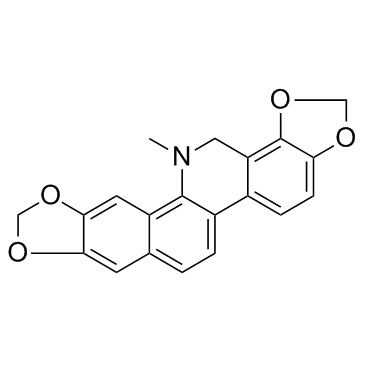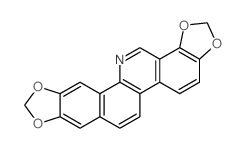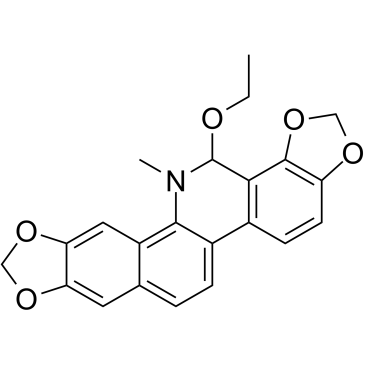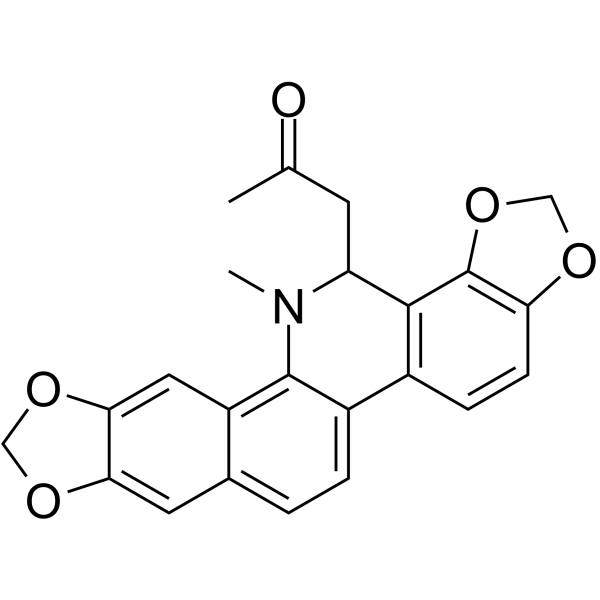CHEMICAL IDENTIFICATION
-
RTECS NUMBER :
-
VP5220000
-
CHEMICAL NAME :
-
Sanguinarine, chloride
-
CAS REGISTRY NUMBER :
-
5578-73-4
-
LAST UPDATED :
-
199712
-
DATA ITEMS CITED :
-
7
-
MOLECULAR FORMULA :
-
C20-H14-N-O4.Cl
HEALTH HAZARD DATA
ACUTE TOXICITY DATA
-
TYPE OF TEST :
-
LD50 - Lethal dose, 50 percent kill
-
ROUTE OF EXPOSURE :
-
Oral
-
SPECIES OBSERVED :
-
Rodent - rat
-
DOSE/DURATION :
-
1658 mg/kg
-
TOXIC EFFECTS :
-
Behavioral - somnolence (general depressed activity) Behavioral - ataxia Gastrointestinal - hypermotility, diarrhea
-
REFERENCE :
-
JTEHD6 Journal of Toxicology and Environmental Health. (Hemisphere Pub., 1025 Vermont Ave., NW, Washington, DC 20005) V.1- 1975/76- Volume(issue)/page/year: 20,199,1987
-
TYPE OF TEST :
-
LDLo - Lowest published lethal dose
-
ROUTE OF EXPOSURE :
-
Intraperitoneal
-
SPECIES OBSERVED :
-
Rodent - rat
-
DOSE/DURATION :
-
20 mg/kg
-
TOXIC EFFECTS :
-
Details of toxic effects not reported other than lethal dose value
-
REFERENCE :
-
NATUAS Nature. (Nature Subscription Dept., POB 1018, Manasguan, NJ 08736) V.1- 1869- Volume(issue)/page/year: 162,265,1948
-
TYPE OF TEST :
-
LD50 - Lethal dose, 50 percent kill
-
ROUTE OF EXPOSURE :
-
Intravenous
-
SPECIES OBSERVED :
-
Rodent - rat
-
DOSE/DURATION :
-
29 mg/kg
-
TOXIC EFFECTS :
-
Behavioral - somnolence (general depressed activity) Behavioral - ataxia Gastrointestinal - hypermotility, diarrhea
-
REFERENCE :
-
JTEHD6 Journal of Toxicology and Environmental Health. (Hemisphere Pub., 1025 Vermont Ave., NW, Washington, DC 20005) V.1- 1975/76- Volume(issue)/page/year: 20,199,1987
-
TYPE OF TEST :
-
LD50 - Lethal dose, 50 percent kill
-
ROUTE OF EXPOSURE :
-
Subcutaneous
-
SPECIES OBSERVED :
-
Rodent - mouse
-
DOSE/DURATION :
-
102 mg/kg
-
TOXIC EFFECTS :
-
Details of toxic effects not reported other than lethal dose value
-
REFERENCE :
-
PLMEAA Planta Medica. (Georg Thieme Verlag, Postfach 732, D-7000 Stuttgart 1, Fed. Rep. Ger.) V.1- 1953- Volume(issue)/page/year: 43,161,1981
-
TYPE OF TEST :
-
LD50 - Lethal dose, 50 percent kill
-
ROUTE OF EXPOSURE :
-
Intravenous
-
SPECIES OBSERVED :
-
Rodent - mouse
-
DOSE/DURATION :
-
15900 ug/kg
-
TOXIC EFFECTS :
-
Details of toxic effects not reported other than lethal dose value
-
REFERENCE :
-
PLMEAA Planta Medica. (Georg Thieme Verlag, Postfach 732, D-7000 Stuttgart 1, Fed. Rep. Ger.) V.1- 1953- Volume(issue)/page/year: 43,161,1981 ** OTHER MULTIPLE DOSE TOXICITY DATA **
-
TYPE OF TEST :
-
TDLo - Lowest published toxic dose
-
ROUTE OF EXPOSURE :
-
Oral
-
SPECIES OBSERVED :
-
Rodent - rat
-
DOSE/DURATION :
-
73 mg/kg/1W-I
-
TOXIC EFFECTS :
-
Related to Chronic Data - death
-
REFERENCE :
-
NATUAS Nature. (Nature Subscription Dept., POB 1018, Manasguan, NJ 08736) V.1- 1869- Volume(issue)/page/year: 162,265,1948
-
TYPE OF TEST :
-
TDLo - Lowest published toxic dose
-
ROUTE OF EXPOSURE :
-
Oral
-
SPECIES OBSERVED :
-
Rodent - rat
-
DOSE/DURATION :
-
2700 ug/kg/2W-C
-
TOXIC EFFECTS :
-
Liver - changes in liver weight
-
REFERENCE :
-
JTEHD6 Journal of Toxicology and Environmental Health. (Hemisphere Pub., 1025 Vermont Ave., NW, Washington, DC 20005) V.1- 1975/76- Volume(issue)/page/year: 29,199,1987
|

 CAS#:3606-45-9
CAS#:3606-45-9 CAS#:548-30-1
CAS#:548-30-1![methyl 5-iodobenzo[d][1,3]dioxole-4-carboxylate Structure](https://image.chemsrc.com/caspic/113/33842-29-4.png) CAS#:33842-29-4
CAS#:33842-29-4![5-iodobenzo[d][1,3]dioxole-4-carboxylic acid Structure](https://image.chemsrc.com/caspic/145/1309123-33-8.png) CAS#:1309123-33-8
CAS#:1309123-33-8![5-iodobenzo[d][1,3]dioxole-4-carbaldehyde Structure](https://image.chemsrc.com/caspic/465/249636-72-4.png) CAS#:249636-72-4
CAS#:249636-72-4 CAS#:522-30-5
CAS#:522-30-5 CAS#:28342-31-6
CAS#:28342-31-6 CAS#:37687-34-6
CAS#:37687-34-6
